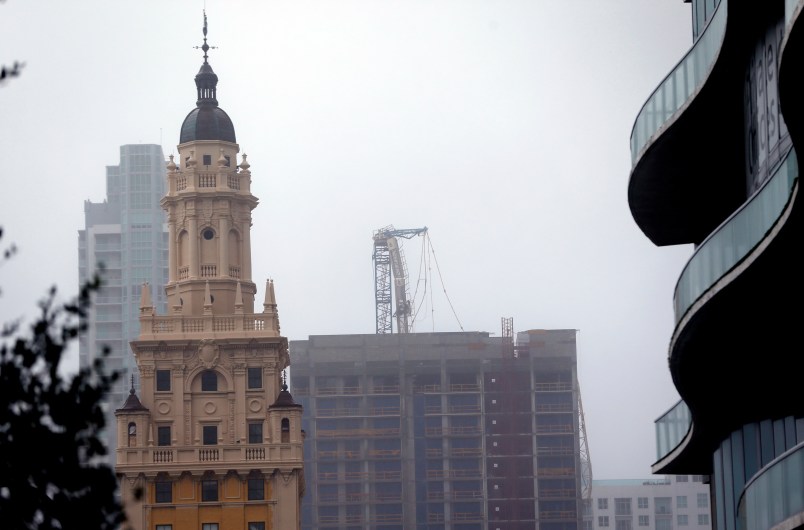MIAMI (AP) — A crane atop a high-rise building under construction collapsed Sunday in downtown Miami amid strong winds from Hurricane Irma — the first known crash of the two dozen such heavyweight hazards looming over the city skyline as the monster storm powers across the state.
The crane collapsed and fell into the top of a building under construction, said Miami City Manager Daniel Alfonso. The bayfront area is filled with hotels and high-rise condo and office buildings, near AmericanAirlines Arena.
It wasn’t immediately clear whether the collapse caused any injuries.
Emergency personnel were unable to respond because of high winds, Miami-Dade County Director of Communications Mike Hernandez said.
The city has contacted the contractor and has contacted the Occupational Safety and Health Administration, which will lead the investigation, Alfonso said.
Some two dozen other cranes in the city were still upright, Alfonso said.
The city identified two dozen tower cranes working on construction sites as a concern ahead of Irma.
They could not be moved ahead of Irma because the massive equipment, with counterbalances weighing up to 30,000 pounds, is a slow process that would take about two weeks to complete, according to city officials.
Abby Ape lives near where the crane collapsed in downtown Miami. She told The Associated Press that from her 14th floor apartment, she saw the crane toppled over where it hit another building.
“We heard a loud crack toward the bay,” Ape said. “It was toppling over. The top portion that most people see is broken in half. It has fallen and hit a building.”
She also could see another nearby construction crane spinning, and she said she felt anxious about her family’s safety. They planned to run into a stairwell if anything else happened.
“I know it was very difficult to bring down in two weeks,” Ape said. “In the future there should be an easy way to bring them down in events like this one.”
Though 110 miles (180 kilometers) from Irma’s landfall in the Florida Keys, hurricane-force winds from the 400-mile-wide storm were being felt through the Miami area. Gusts over 90 mph (145 kph) were reported at Miami International Airport.
The National Hurricane Center said winds “affecting the upper floors of high-rise buildings will be significantly stronger than those near ground level.”
The city and surrounding areas were under a tornado watch Sunday.
Officials urged people in buildings facing the crane to seek shelter on the opposite side of the building or in a stairwell.
“AVOID THE AREA!!” the city’s tweet said.
Dan Whiteman, vice chairman of Coastal Construction, has 12 cranes in the Miami area. He said videos of the collapse posted on social media showed a luffing crane, which lacks a horizontal arm and does not spin.
The same videos showed his tower cranes spinning in the background.
“The luffing crane cannot rotate like a weather vane,” Whiteman said. “Our cranes are still weather vane-ing.”
Only a few contractors are certified to remove those cranes, and they would not have had enough time to move them out of harm’s way even if they all were working at the same time in Miami to prepare for Irma, he said.
Tower cranes can rise hundreds of feet into the air on steel frameworks, and are used to lift steel, concrete, heavy construction equipment and other building materials.
The horizontal arms of some cranes were left loose to spin in the winds. The equipment was designed to withstand winds up to 145 mph (233 kph), city officials said.
A tornado could have ripped the crane loose, Whiteman said.
“Hurricane winds are blowing in one direction but a tornado could twist things, and nothing can be designed to withstand the tornado effect,” Whiteman said.







Now-deleted tweet, via Digby:
Still up, from an hour ago:
Actual conditions in Miami:
Wanna bet she’s nowhere near Florida right now?
If there’s any justice her house will be leveled — with her in it!
The desperately irrelevant desperately trying to be relevant.
Bet she took off before the storm on her broom…
Or hitched a ride with a lardy, loud-mouthed wannabe macho man in his Gulfstream IV.
Unfortunately, it was grounded so they’re waiting for stand-by seating on Delta.